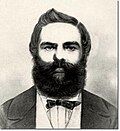| Portrait | Name | Term of office |
|---|
| Political Agents |
 | Captain Stafford Bettesworth Haines, Indian Navy | 1839 | 1854 |
 | Major-General James Outram | 1854 | 1856 |
| Political Residents |
| Colonel William Marcus Coghlan | 1854 | 1862 |
| Major-General R. W. Honner | 1862 | 1862 |
| Colonel William Marcus Coghlan | 1862 | 1863 |
 | Major William Merewether | 1863 | 1867 |
| Major-General Sir Edward Russell | 1867 | 1870 |
| Major-General Charles William Tremenheere | 1870 | 1872 |
| Brigadier John Schneider | 1872 | 1877 |
| Brigadier Francis Adam Ellis Loch | 1877 | 1882 |
 | Brigadier James Blair | 1882 | 1885 |
| Brigadier Adam George Forbes Hogg | 1890 | 1890 |
| Brigadier John Jopp | 1890 | 1895 |
| Brigadier Charles Alexander Cunningham | 1895 | 1899 |
 | Brigadier Garratt O'Moore Creagh | 1899 | 1901 |
| Brigadier Pelham James Maitland | 1901 | 1904 |
| Major-General Harry Macan Mason | 1904 | 1906 |
 | Major-General Ernest de Brath | 1906 | 1910 |
 | Brigadier James Alexander Bell | 1910 | 1914 |
| Brigadier Charles Henry Uvedale Price | 1915 | 1915 |
| Major-General James Marshall Stewart | 1916 | 1920 |
 | Major-General Thomas Edwin Scott | 1920 | 1925 |
| Major-General John Henry Keith Stewart | 1925 | 1928 |
 | Lieutenant Colonel George Stewart Symes | 1928 | 1930 |
 | Lieutenant Colonel Bernard Rawdon Reilly | 1930 | 1932 |
| Chief Commissioner |
 | Lieutenant Colonel Bernard Rawdon Reilly | 1932 | 1937 |
| Governors |
 | Sir Bernard Reilly | 1937 | 1940 |
| Sir John Hathorn Hall | 1940 | 1944 |
| Sir Reginald Champion | 1944 | 1951 |
| Sir Tom Hickinbotham [3] [4] | 1951 | 1956 |
| Sir William Henry Luce | 1956 | 1960 |
| Sir Charles Johnston | 1960 | 1963 |
| High Commissioners |
| Sir Kennedy Trevaskis | 1963 | 1965 |
| Sir Richard Turnbull | 1965 | 1967 |
| Sir Humphrey Trevelyan | 1967 | 1967 |
|












